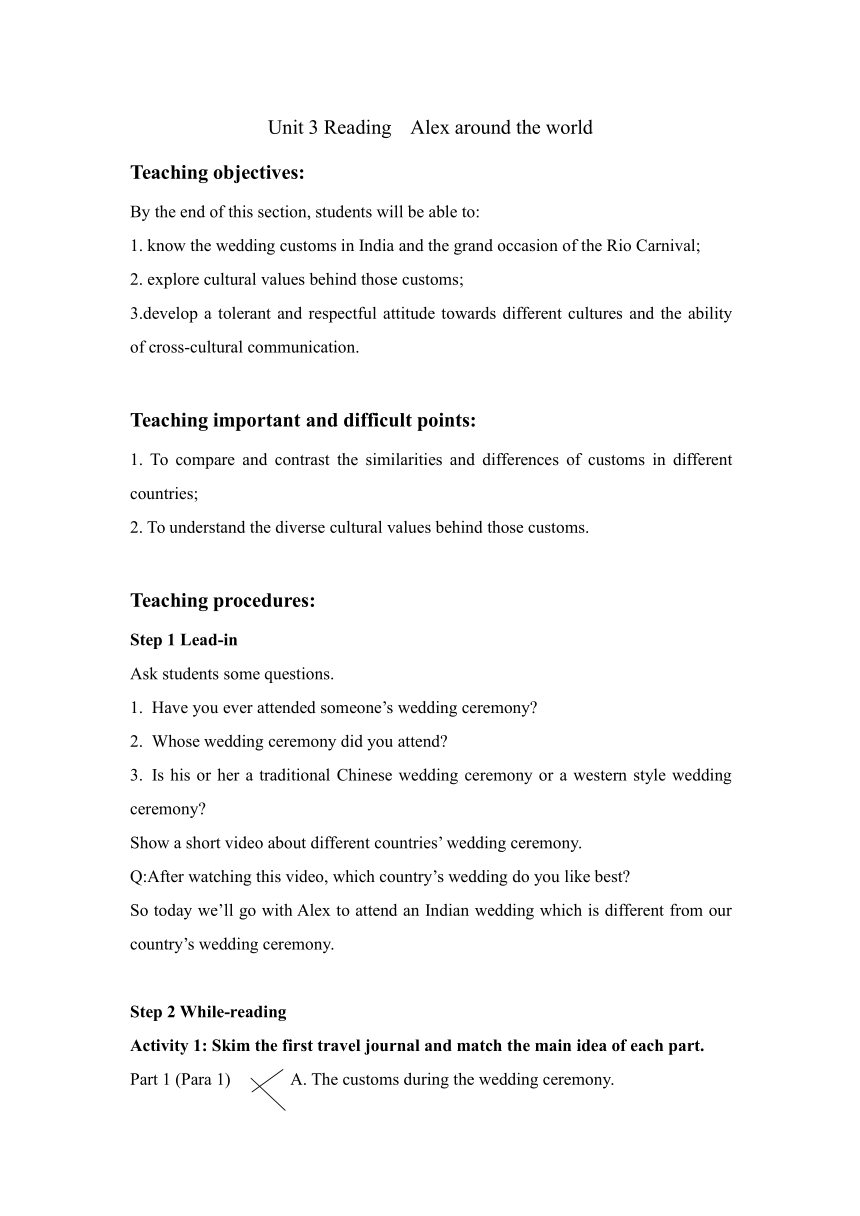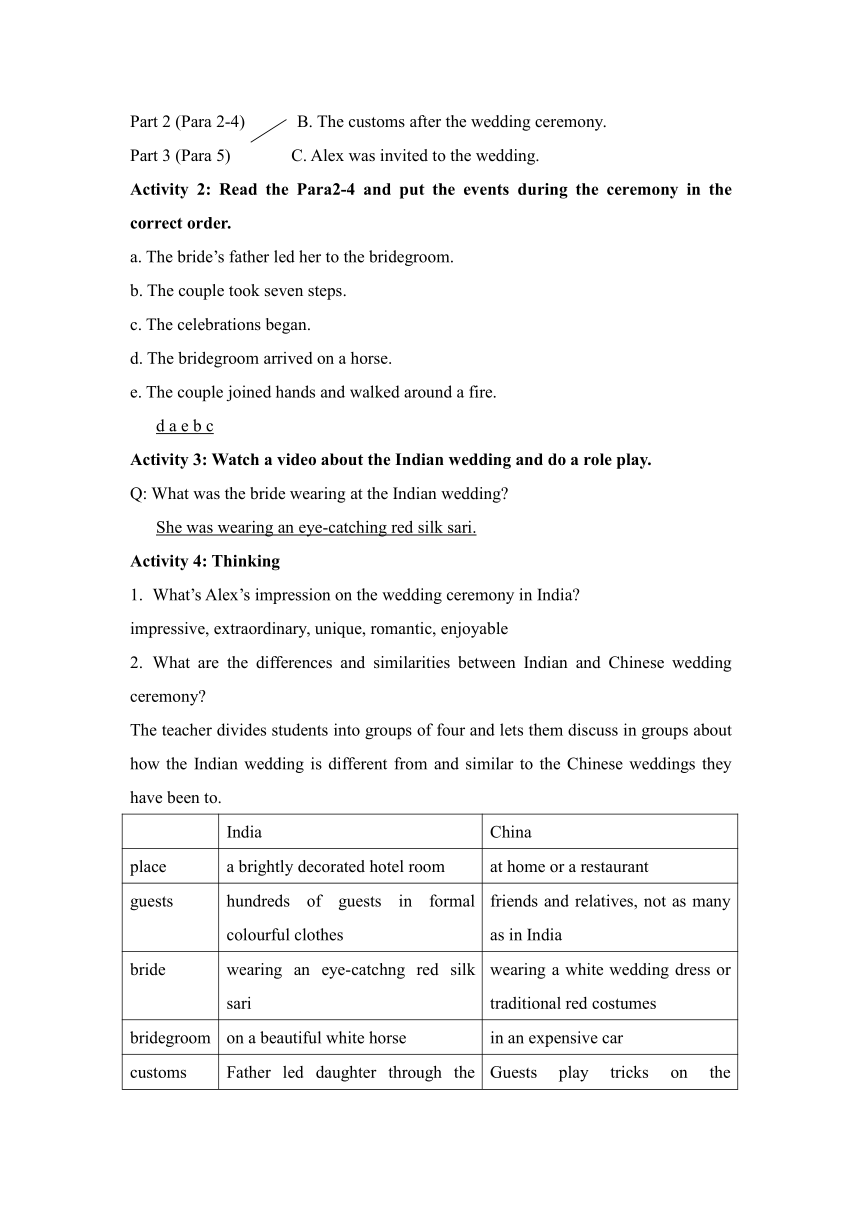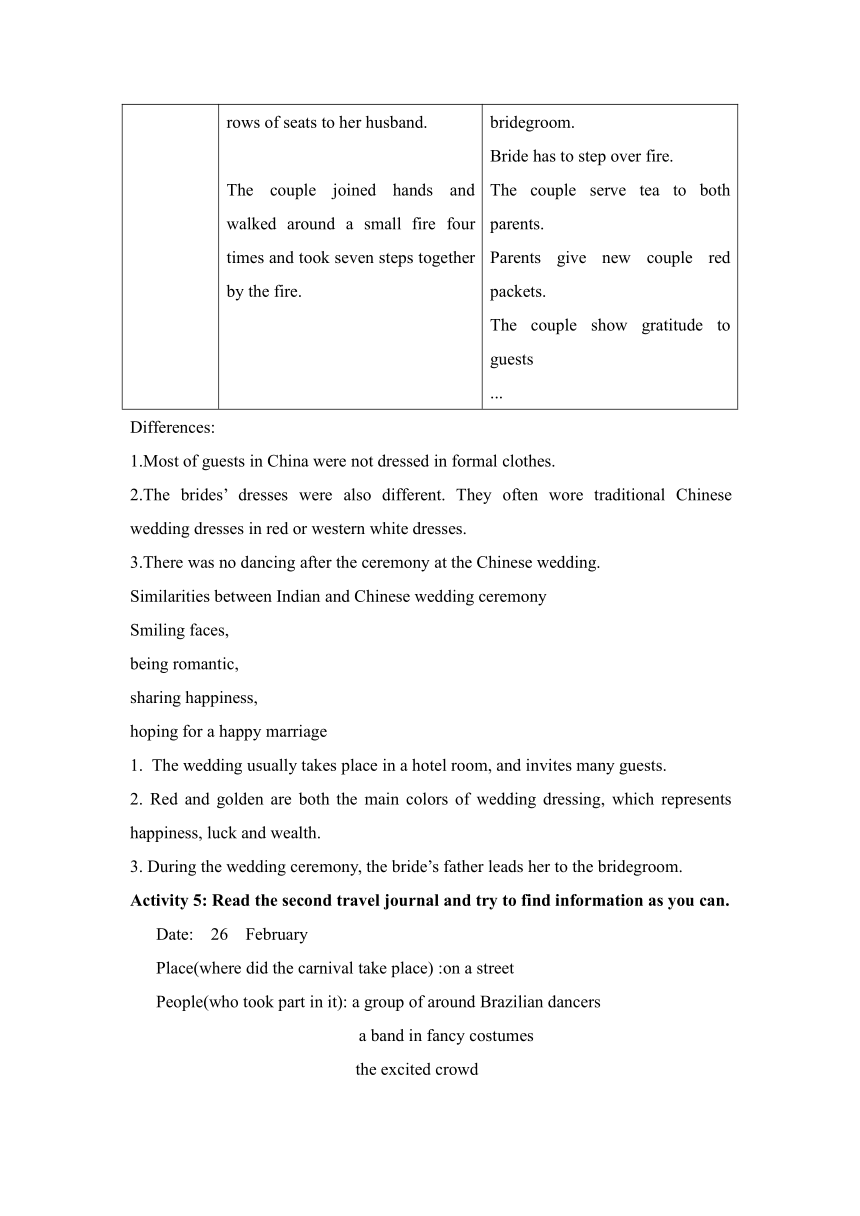译林版(2020)必修第二册Unit 3 Festivals and customs Reading Alex around the world 教学设计
文档属性
| 名称 | 译林版(2020)必修第二册Unit 3 Festivals and customs Reading Alex around the world 教学设计 |

|
|
| 格式 | docx | ||
| 文件大小 | 27.0KB | ||
| 资源类型 | 教案 | ||
| 版本资源 | 牛津译林版(2019) | ||
| 科目 | 英语 | ||
| 更新时间 | 2024-12-17 14:16:24 | ||
图片预览



文档简介
Unit 3 Reading Alex around the world
Teaching objectives:
By the end of this section, students will be able to:
1. know the wedding customs in India and the grand occasion of the Rio Carnival;
2. explore cultural values behind those customs;
3.develop a tolerant and respectful attitude towards different cultures and the ability of cross-cultural communication.
Teaching important and difficult points:
1. To compare and contrast the similarities and differences of customs in different countries;
2. To understand the diverse cultural values behind those customs.
Teaching procedures:
Step 1 Lead-in
Ask students some questions.
Have you ever attended someone’s wedding ceremony
Whose wedding ceremony did you attend
Is his or her a traditional Chinese wedding ceremony or a western style wedding ceremony
Show a short video about different countries’ wedding ceremony.
Q:After watching this video, which country’s wedding do you like best
So today we’ll go with Alex to attend an Indian wedding which is different from our country’s wedding ceremony.
Step 2 While-reading
Activity 1: Skim the first travel journal and match the main idea of each part.
Part 1 (Para 1) A. The customs during the wedding ceremony.
Part 2 (Para 2-4) B. The customs after the wedding ceremony.
Part 3 (Para 5) C. Alex was invited to the wedding.
Activity 2: Read the Para2-4 and put the events during the ceremony in the correct order.
a. The bride’s father led her to the bridegroom.
b. The couple took seven steps.
c. The celebrations began.
d. The bridegroom arrived on a horse.
e. The couple joined hands and walked around a fire.
d a e b c
Activity 3: Watch a video about the Indian wedding and do a role play.
Q: What was the bride wearing at the Indian wedding
She was wearing an eye-catching red silk sari.
Activity 4: Thinking
What’s Alex’s impression on the wedding ceremony in India
impressive, extraordinary, unique, romantic, enjoyable
What are the differences and similarities between Indian and Chinese wedding ceremony
The teacher divides students into groups of four and lets them discuss in groups about how the Indian wedding is different from and similar to the Chinese weddings they have been to.
India China
place a brightly decorated hotel room at home or a restaurant
guests hundreds of guests in formal colourful clothes friends and relatives, not as many as in India
bride wearing an eye-catchng red silk sari wearing a white wedding dress or traditional red costumes
bridegroom on a beautiful white horse in an expensive car
customs Father led daughter through the rows of seats to her husband. The couple joined hands and walked around a small fire four times and took seven steps together by the fire. Guests play tricks on the bridegroom. Bride has to step over fire. The couple serve tea to both parents. Parents give new couple red packets. The couple show gratitude to guests ...
Differences:
1.Most of guests in China were not dressed in formal clothes.
2.The brides’ dresses were also different. They often wore traditional Chinese wedding dresses in red or western white dresses.
3.There was no dancing after the ceremony at the Chinese wedding.
Similarities between Indian and Chinese wedding ceremony
Smiling faces,
being romantic,
sharing happiness,
hoping for a happy marriage
The wedding usually takes place in a hotel room, and invites many guests.
2. Red and golden are both the main colors of wedding dressing, which represents happiness, luck and wealth.
3. During the wedding ceremony, the bride’s father leads her to the bridegroom.
Activity 5: Read the second travel journal and try to find information as you can.
Date: 26 February
Place(where did the carnival take place) :on a street
People(who took part in it): a group of around Brazilian dancers
a band in fancy costumes
the excited crowd
Activity(what did they do) : The dancers twisted and turned.
The band started playing an energetic samba beat
The crowd began to cheer, clap and sing.
What could you see and hear:an explosion of bright colours and lively music
Alex’s feelings(use some adjectives): happy, merry, exciting, enjoyable, unforgettable, amazing
Activity 6: What information can you get from Para.1
It was very hot outside.
Brazilians were extremely excited about the Carnival.
Activity 7: Read Para.7-8 and put the events at the Rio Carnival in the correct order.
The Rio Carnival
a. The group started marching down the street.
b. Alex saw dancers and musicians standing in the street.
c. Alex took his place in the crowd.
d. The group jumped into action.
e. The crowd passed many street stands.
C B D A E
Activity 8: Discussion
Q:What does Alex think of the Rio Carnival Use details in the travel journal to support your opinion.
He called the Carnival a “happy occasion”. He also described his first day in Rio as “amazing”.
Q:How do you know
He was so caught up in the party fever that he hardly noticed five hours fly by!
Even as he lay in bed that evening, the bright colours and lively music were still swimming all around him.
Step 3 Post-reading
Activity 9: Critical thinking
Besides weddings and festivals, what other elements are an important part of a country’s customs and traditions Make a list and describe them.
funeral rituals
At traditional Chinese funerals, people wear white. In Western countries people usually wear black.
honoring new life
In China, a celebration is held when a baby turns one month old and this is traditionally the time when the baby is formally introduced to the extended family and friends.
table manners
According to Chinese customs, no one should sit down or begin to eat before the host or guest of honour has done so.
What’s the significance of knowing different countries’ customs and traditions
Customs tell a man who he is, where he belongs, what he must do.
—Robert A. Heinlein
broaden the perspective
makes it easier to be accepted by people from other countries
build a harmonious relationship
arouse the urge to experience them in person
avoid misunderstanding in communication
establish a good image
What principles should we follow when communicating with people from different countries
Respect different people’s customs and traditions, their values and privacy
Seek common ground while shelving differences
Make an effort to build a human community with a shared future
Activity 11: Discussion
1. Why should we still need to observe traditional festivals nowadays
They are a source of national pride and culture heritage , which can help shape national identity and spread knowledge about national history and pass down on virtues to next generation...
2. What should we do when we are in different countries
Respect other's cultures, customs and traditions. Learn about them before travelling and avoid some taboos. When in Rome, do as romans do.
Step 4 Homework
Try to find more information about Indian wedding ceremony and the Carnival on the Internet.
Teaching objectives:
By the end of this section, students will be able to:
1. know the wedding customs in India and the grand occasion of the Rio Carnival;
2. explore cultural values behind those customs;
3.develop a tolerant and respectful attitude towards different cultures and the ability of cross-cultural communication.
Teaching important and difficult points:
1. To compare and contrast the similarities and differences of customs in different countries;
2. To understand the diverse cultural values behind those customs.
Teaching procedures:
Step 1 Lead-in
Ask students some questions.
Have you ever attended someone’s wedding ceremony
Whose wedding ceremony did you attend
Is his or her a traditional Chinese wedding ceremony or a western style wedding ceremony
Show a short video about different countries’ wedding ceremony.
Q:After watching this video, which country’s wedding do you like best
So today we’ll go with Alex to attend an Indian wedding which is different from our country’s wedding ceremony.
Step 2 While-reading
Activity 1: Skim the first travel journal and match the main idea of each part.
Part 1 (Para 1) A. The customs during the wedding ceremony.
Part 2 (Para 2-4) B. The customs after the wedding ceremony.
Part 3 (Para 5) C. Alex was invited to the wedding.
Activity 2: Read the Para2-4 and put the events during the ceremony in the correct order.
a. The bride’s father led her to the bridegroom.
b. The couple took seven steps.
c. The celebrations began.
d. The bridegroom arrived on a horse.
e. The couple joined hands and walked around a fire.
d a e b c
Activity 3: Watch a video about the Indian wedding and do a role play.
Q: What was the bride wearing at the Indian wedding
She was wearing an eye-catching red silk sari.
Activity 4: Thinking
What’s Alex’s impression on the wedding ceremony in India
impressive, extraordinary, unique, romantic, enjoyable
What are the differences and similarities between Indian and Chinese wedding ceremony
The teacher divides students into groups of four and lets them discuss in groups about how the Indian wedding is different from and similar to the Chinese weddings they have been to.
India China
place a brightly decorated hotel room at home or a restaurant
guests hundreds of guests in formal colourful clothes friends and relatives, not as many as in India
bride wearing an eye-catchng red silk sari wearing a white wedding dress or traditional red costumes
bridegroom on a beautiful white horse in an expensive car
customs Father led daughter through the rows of seats to her husband. The couple joined hands and walked around a small fire four times and took seven steps together by the fire. Guests play tricks on the bridegroom. Bride has to step over fire. The couple serve tea to both parents. Parents give new couple red packets. The couple show gratitude to guests ...
Differences:
1.Most of guests in China were not dressed in formal clothes.
2.The brides’ dresses were also different. They often wore traditional Chinese wedding dresses in red or western white dresses.
3.There was no dancing after the ceremony at the Chinese wedding.
Similarities between Indian and Chinese wedding ceremony
Smiling faces,
being romantic,
sharing happiness,
hoping for a happy marriage
The wedding usually takes place in a hotel room, and invites many guests.
2. Red and golden are both the main colors of wedding dressing, which represents happiness, luck and wealth.
3. During the wedding ceremony, the bride’s father leads her to the bridegroom.
Activity 5: Read the second travel journal and try to find information as you can.
Date: 26 February
Place(where did the carnival take place) :on a street
People(who took part in it): a group of around Brazilian dancers
a band in fancy costumes
the excited crowd
Activity(what did they do) : The dancers twisted and turned.
The band started playing an energetic samba beat
The crowd began to cheer, clap and sing.
What could you see and hear:an explosion of bright colours and lively music
Alex’s feelings(use some adjectives): happy, merry, exciting, enjoyable, unforgettable, amazing
Activity 6: What information can you get from Para.1
It was very hot outside.
Brazilians were extremely excited about the Carnival.
Activity 7: Read Para.7-8 and put the events at the Rio Carnival in the correct order.
The Rio Carnival
a. The group started marching down the street.
b. Alex saw dancers and musicians standing in the street.
c. Alex took his place in the crowd.
d. The group jumped into action.
e. The crowd passed many street stands.
C B D A E
Activity 8: Discussion
Q:What does Alex think of the Rio Carnival Use details in the travel journal to support your opinion.
He called the Carnival a “happy occasion”. He also described his first day in Rio as “amazing”.
Q:How do you know
He was so caught up in the party fever that he hardly noticed five hours fly by!
Even as he lay in bed that evening, the bright colours and lively music were still swimming all around him.
Step 3 Post-reading
Activity 9: Critical thinking
Besides weddings and festivals, what other elements are an important part of a country’s customs and traditions Make a list and describe them.
funeral rituals
At traditional Chinese funerals, people wear white. In Western countries people usually wear black.
honoring new life
In China, a celebration is held when a baby turns one month old and this is traditionally the time when the baby is formally introduced to the extended family and friends.
table manners
According to Chinese customs, no one should sit down or begin to eat before the host or guest of honour has done so.
What’s the significance of knowing different countries’ customs and traditions
Customs tell a man who he is, where he belongs, what he must do.
—Robert A. Heinlein
broaden the perspective
makes it easier to be accepted by people from other countries
build a harmonious relationship
arouse the urge to experience them in person
avoid misunderstanding in communication
establish a good image
What principles should we follow when communicating with people from different countries
Respect different people’s customs and traditions, their values and privacy
Seek common ground while shelving differences
Make an effort to build a human community with a shared future
Activity 11: Discussion
1. Why should we still need to observe traditional festivals nowadays
They are a source of national pride and culture heritage , which can help shape national identity and spread knowledge about national history and pass down on virtues to next generation...
2. What should we do when we are in different countries
Respect other's cultures, customs and traditions. Learn about them before travelling and avoid some taboos. When in Rome, do as romans do.
Step 4 Homework
Try to find more information about Indian wedding ceremony and the Carnival on the Internet.
